Huge turnout hears criticism of further UNO charter schools' expansion plans into De la Cruz building, while UNO packs meeting, then stages disruptive walkout
More than 200 people, most of them from the Pilsen and Little Village communities, spent their Friday night in a crowded meeting room at St. Augustine College at 25th and Rockwell on Chicago's southwest side on August 21, 2009, to hear plans for the further expansion of the controversial UNO charter schools.
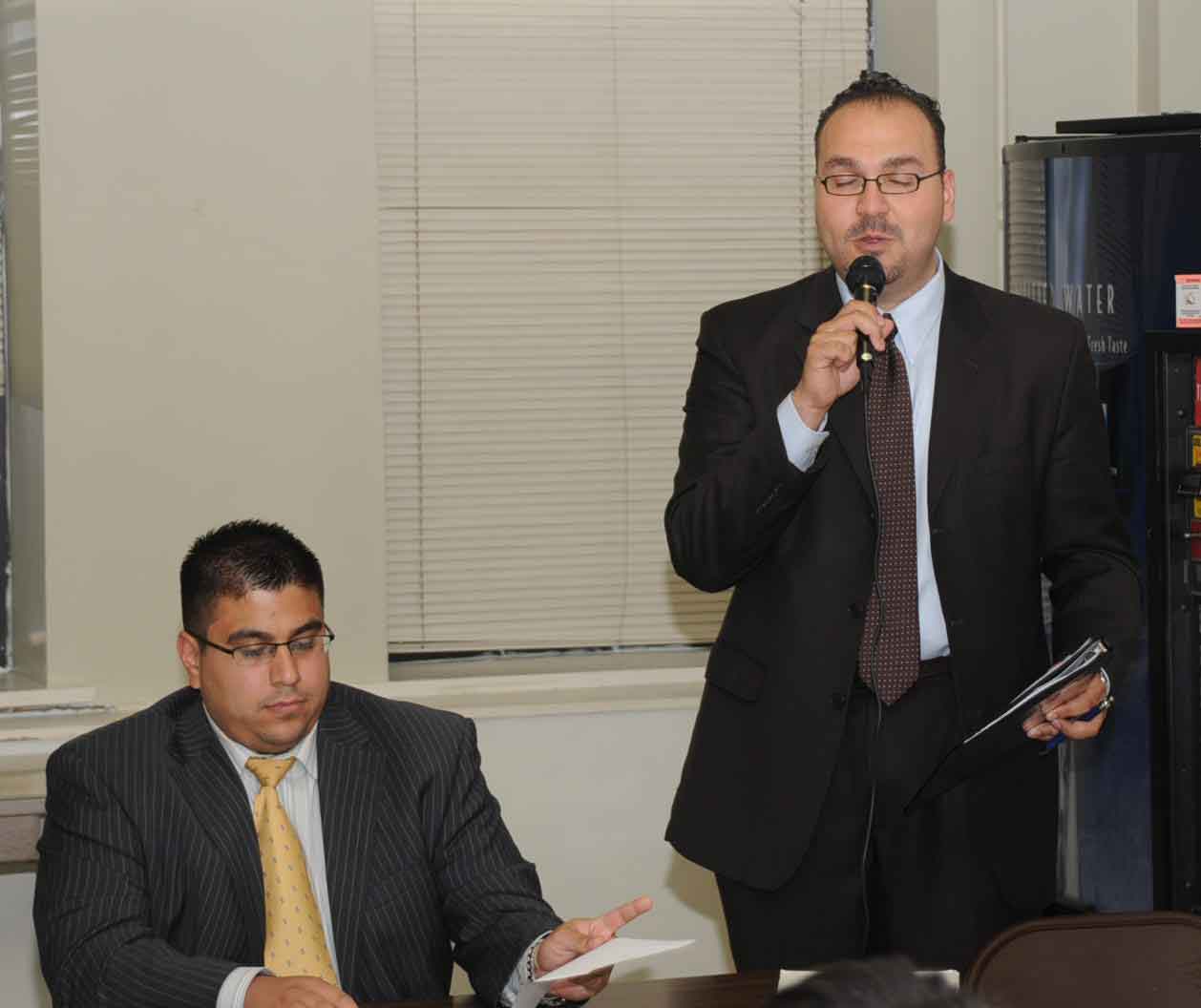 Jaime Guzman (above, holding microphone) holds the title "Director, External Relations and Special Projects, Office of New Schools, Chicago Public Schools". Guzman opened the meeting with a presentation in support of the UNO proposal, but refused to provide the public with anything more than a verbal narrative. Over the course of three years, Guzman has become known at Substance for his constant attempts to thwart the provisions of public information regarding charter schools. Most of the staff of the so-called "Office of New Schools" are people with corporate backgrounds and little or no teaching or public school administrative experience. Because the Chicago Public Schools and the Office of New Schools maintain that information about the qualifications of its $100,000-per-year executives is not "public information," Substance cannot verify continuing reports that Guzman works in a part of the 5th Floor at CPS headquarters that contains almost no teachers or staff with teaching experience and certification. Substance photo by George N. Schmidt.This time, the main proposal was to give UNO charter schools the recently closed building that had housed the De La Cruz Middle School (2317 W. 23rd Place) a mile from the site of the Friday night meeting. Some community leaders even gave the opinion that CPS deliberately chose the St. Augustine College site (west of Western Ave.) — rather than a public school site near the De La Cruz location — to enable UNO to pack the meeting with its supporters.
Jaime Guzman (above, holding microphone) holds the title "Director, External Relations and Special Projects, Office of New Schools, Chicago Public Schools". Guzman opened the meeting with a presentation in support of the UNO proposal, but refused to provide the public with anything more than a verbal narrative. Over the course of three years, Guzman has become known at Substance for his constant attempts to thwart the provisions of public information regarding charter schools. Most of the staff of the so-called "Office of New Schools" are people with corporate backgrounds and little or no teaching or public school administrative experience. Because the Chicago Public Schools and the Office of New Schools maintain that information about the qualifications of its $100,000-per-year executives is not "public information," Substance cannot verify continuing reports that Guzman works in a part of the 5th Floor at CPS headquarters that contains almost no teachers or staff with teaching experience and certification. Substance photo by George N. Schmidt.This time, the main proposal was to give UNO charter schools the recently closed building that had housed the De La Cruz Middle School (2317 W. 23rd Place) a mile from the site of the Friday night meeting. Some community leaders even gave the opinion that CPS deliberately chose the St. Augustine College site (west of Western Ave.) — rather than a public school site near the De La Cruz location — to enable UNO to pack the meeting with its supporters.
The current UNO charter school is west of Western Ave. (a major dividing line in the community) and residents east of Western have long been organized in opposition to any expansion of UNO's charter schools. Locating the hearing west of Western was an indication to some that those who hosted the hearing did not want to hear from the community which will be affected by the arrival of the new charter school. This was reinforced by other events that preceded the hearing, including the method of notification and the actions of UNO supporters (who walked out during the hearing itself when people from Whittier Elementary School began presenting their testimony).
'Hearing' biased towards UNO from the begnning
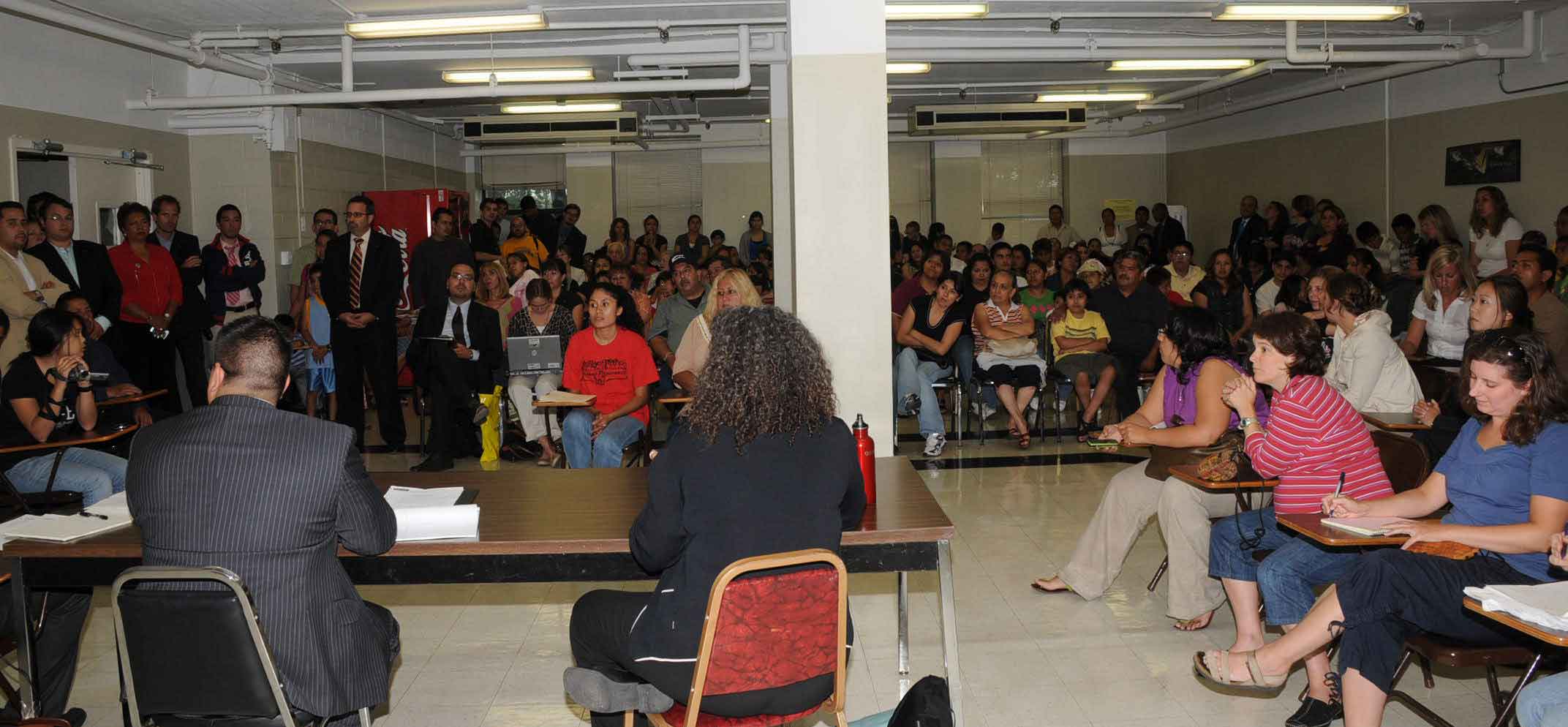 Part of the crowd that assembled for the hastily called "hearing" on the proposal to place the United Neighborhood Organization (UNO) Octavio Paz charter school into the recently closed De La Cruz elementary school building on August 21, 2009. More than 200 people, including more than 40 children, were in the St. Augustine College meeting room by the time the hearing officially began at 6:15 p.m. In the foreground (backs to camera) are the hearing officer and a CPS official. After UNO chief Juan Rangal presented his organization's proposal to take over the De La Cruz building, more than 30 speakers (out of a total of more than 50 who had signed up) spoke passionately for and against the proposal. Substance photo by George N. Schmidt. The hastily called meeting, which was under the aegis of the Chicago Board of Education's "Office of New Schools," was a "hearing" on the question of whether UNO's Octavio Paz charter school should be allowed to expand into the recently closed De La Cruz school building. [The reason why this article will utilize the convention of quotation marks around the word "hearing" will be explained at the end of this article.]
Part of the crowd that assembled for the hastily called "hearing" on the proposal to place the United Neighborhood Organization (UNO) Octavio Paz charter school into the recently closed De La Cruz elementary school building on August 21, 2009. More than 200 people, including more than 40 children, were in the St. Augustine College meeting room by the time the hearing officially began at 6:15 p.m. In the foreground (backs to camera) are the hearing officer and a CPS official. After UNO chief Juan Rangal presented his organization's proposal to take over the De La Cruz building, more than 30 speakers (out of a total of more than 50 who had signed up) spoke passionately for and against the proposal. Substance photo by George N. Schmidt. The hastily called meeting, which was under the aegis of the Chicago Board of Education's "Office of New Schools," was a "hearing" on the question of whether UNO's Octavio Paz charter school should be allowed to expand into the recently closed De La Cruz school building. [The reason why this article will utilize the convention of quotation marks around the word "hearing" will be explained at the end of this article.]
The UNO Octavio Paz school has been housed in the St. Roman Catholic School building at 25th and Washtenaw for several years. UNO is now claiming that the St. Roman facility is "unsafe", that the "unsafe" condition was only recently discovered (and constitutes an unforeseen emergency), and that there is no other alternative with school starting shortly but to put the UNO charter school inside the De la Cruz building rather than at any other site (either UNO operated of CPS operated). CPS officials and Chicago Board of Education President Michael Scott all have lined up in favor of the UNO version of events and the UNO proposed solution to the supposed problem. Under UNO's plan, the Board of Education is supposed to immediately move UNO's charter school into the De La Cruz building which, until three weeks ago, the Board had claimed would never be used for a charter school and which was supposedly "underutilized" as a public school and which would cost too much to repair to make it suitable for continued use as a public school.
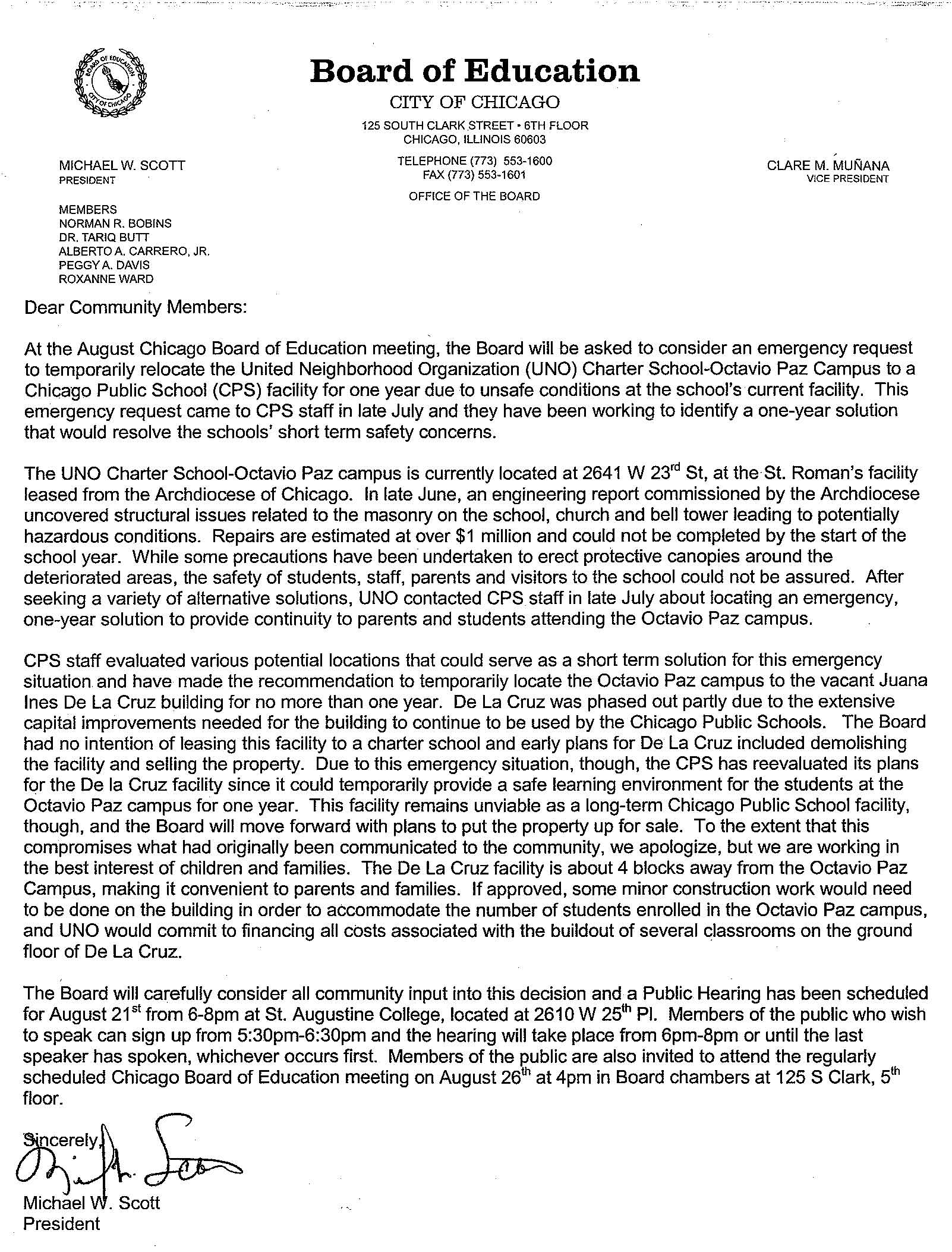 Above, the undated letter from Michael Scott announcing that he would propose that UNO get the De la Cruz building and mentioning the "hearing" scheduled by the CPS Office of New Schools. The repetition of the phrase "emergency situation" struck many as disingenuous, since Scott has supported the massive expansions of the UNO charter schools in the face of parent and community opposition for more than four years. Every time it becomes clear that there is massive opposition to one of Scott's privatization projects, he talks about how parents do not understand what's best for the children in the schools — and then comes out in favor of further deregulation, further privatization, and more charter schools. Because of Scott's participation in the destruction of the public schools of the west side, his own community, he no longer has credibility in the places that once served as his political base. Scott is particularly despised for abetting the privatization of Austin, Collins, and Orr high schools. Substance photo by George N. Schmidt. A last minute letter from Chicago Board of Education President Michael Scott had claimed that an "emergency" situation at the UNO charter school forced the UNO charter school to move. According to Scott's letter, the building in which the UNO school was housed had become to dangerous to utilize as a school. The De la Cruz building was available, since CPS had closed it amid protest in June 2009.
Above, the undated letter from Michael Scott announcing that he would propose that UNO get the De la Cruz building and mentioning the "hearing" scheduled by the CPS Office of New Schools. The repetition of the phrase "emergency situation" struck many as disingenuous, since Scott has supported the massive expansions of the UNO charter schools in the face of parent and community opposition for more than four years. Every time it becomes clear that there is massive opposition to one of Scott's privatization projects, he talks about how parents do not understand what's best for the children in the schools — and then comes out in favor of further deregulation, further privatization, and more charter schools. Because of Scott's participation in the destruction of the public schools of the west side, his own community, he no longer has credibility in the places that once served as his political base. Scott is particularly despised for abetting the privatization of Austin, Collins, and Orr high schools. Substance photo by George N. Schmidt. A last minute letter from Chicago Board of Education President Michael Scott had claimed that an "emergency" situation at the UNO charter school forced the UNO charter school to move. According to Scott's letter, the building in which the UNO school was housed had become to dangerous to utilize as a school. The De la Cruz building was available, since CPS had closed it amid protest in June 2009.
Current fight in the context of CPS charter school expansion plans and what critics call the sabotage of Chicago's regular and traditiional public schools
The proposal to give the De la Cruz building to UNO is supposed to come before the monthly meeting of the Chicago Board of Education on August 26, 2009. During a year of protests against the closing of De La Cruz, De la Cruz teachers, students and community supporters had charged that CPS officials were planning to give the building to UNO for a charter school once it had been eliminated as a public school option for the community.
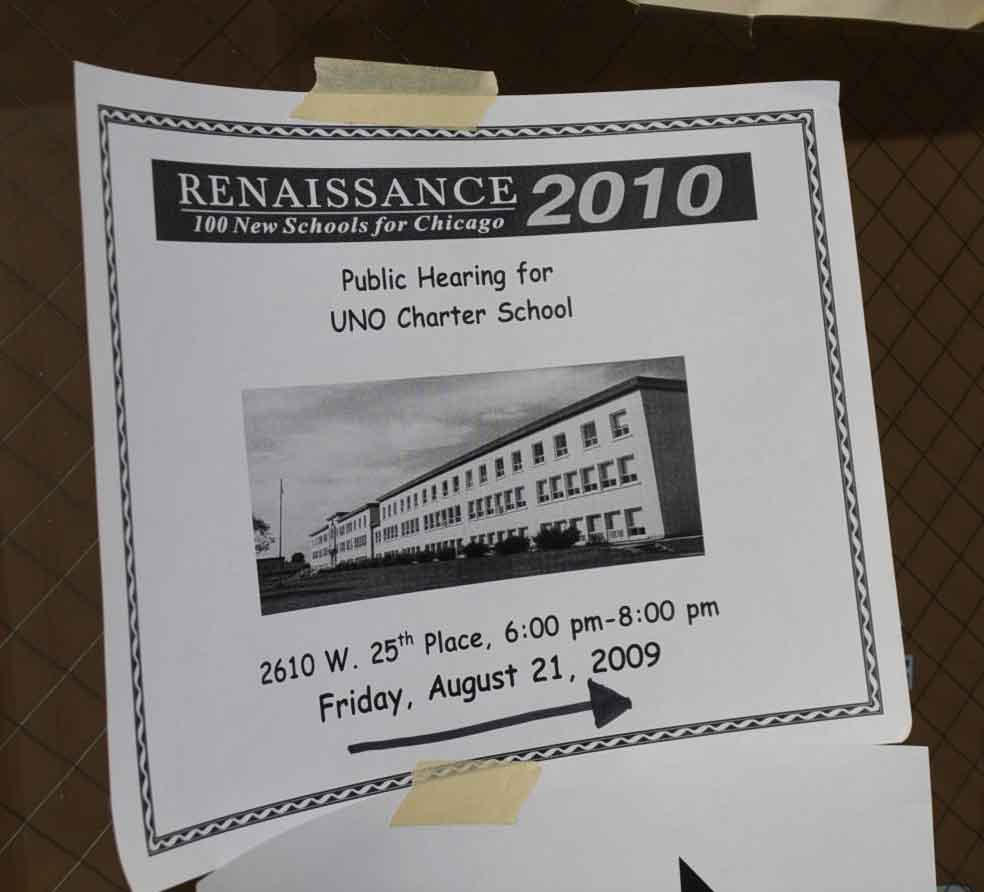 Above: Many speakers at the August 21 hearing criticized the lack of notice to the hearing. The above notice depicted a strange "school" (neither De La Cruz nor Octavio Paz) and didn't mention the actual subject of the hearing itself. Under 'Renaissance 2010, CPS has begun holding 'hearings' that seem to be organized by the Office of New Schools (which oversees Renaissance 2010) specifically to discourage public participation. The August 21 hearing, for example, was held at a location as far as possible in the community from the De La Cruz site or Whittier school, which are the communities most affected by the move of Octavio Paz from west of Western Ave. to east of Western Ave. Substance photo by George N. Schmidt.Two CPS Chief Executive Officers (Arne Duncan and Ron Huberman) and two Chicago Board of Education presidents (Rufus Williams and Michael Scott) have repeatedly told the public that there was no intention of utilizing the De la Cruz facility for a charter school, despite rumors in the community. Officially, public schools representatives have repeated over and over that De La Cruz had to be closed because of the supposed "underutilization" and were also saying that the building would probably be demolished and the land sold.
Above: Many speakers at the August 21 hearing criticized the lack of notice to the hearing. The above notice depicted a strange "school" (neither De La Cruz nor Octavio Paz) and didn't mention the actual subject of the hearing itself. Under 'Renaissance 2010, CPS has begun holding 'hearings' that seem to be organized by the Office of New Schools (which oversees Renaissance 2010) specifically to discourage public participation. The August 21 hearing, for example, was held at a location as far as possible in the community from the De La Cruz site or Whittier school, which are the communities most affected by the move of Octavio Paz from west of Western Ave. to east of Western Ave. Substance photo by George N. Schmidt.Two CPS Chief Executive Officers (Arne Duncan and Ron Huberman) and two Chicago Board of Education presidents (Rufus Williams and Michael Scott) have repeatedly told the public that there was no intention of utilizing the De la Cruz facility for a charter school, despite rumors in the community. Officially, public schools representatives have repeated over and over that De La Cruz had to be closed because of the supposed "underutilization" and were also saying that the building would probably be demolished and the land sold.
Yet once the De la Cruz public public school, its teachers, students and other staff had been safely evicted from the building, UNO was ready to move in. Less than 90 days after the last public school classes were held at the De la Cruz site, Scott's letter confirmed the suspicion, in the eyes of most of the community and teachers at public schools in Pilsen and Little Village.
CPS jargon — "underutilized" (buildings that can be closed and turned over to charters), "underserved" (communities, usually in wealthier areas where the remaining working class families are forced out), and "underperforming" (schools, as measured solely by biased test scores) now going national via the Duncan administration at U.S. Department of Education
Twenty months ago, in January 2008, the Board of Education announced that De la Cruz Middle School in Pilsen would be closed because of what is called "underutilization" and poor building conditions. In order to understand what was done to De la Cruz — and the national implications of the community meeting held in Chicago on August 21 — readers have to spend a small amount of time learning the Orwellian jargon of Arne Duncan and the Chicago Public Schools.
Although most of Chicago's charter schools boast small numbers of students, none of them is ever "underutilized." That term is reserved for neighborhood public schools that CPS wants to destroy so that their buildings can be provided to the so-called "educational entrepreneurs" who get elaborate subsidies — public and private — for opening charter schools within the walls of what were once vibrant public schools.
In order to take away the public schools, during the Duncan years (2001 - 2008) CPS developed an arsenal of new terms that drive the policy of privatization without actually admitting that privatization was behind the activities. Now that Chicago is the national model for what the Obama administration is calling "school reform", it is likely that the jargon will be popping up across the 50 states and those territories that fall under the jurisdiction of the U.S. Department of Education, so it is worth a brief digression to outline the language Chicago has invented to further the destruction of viable public schools and promote privatization through charter schools. The event on the evening of Friday, August 21, 2009, in a gritty ethnic community in the shadow of Chicago's Cook County Jail was likely to be a foreshadowing of the kinds of things soon to be done across the USA as the privatization agenda of the Obama education team takes hold in the coming year.
"Underutilization" is one of several carefully constructed talking points that former CPS Chief Executive Officer Arne Duncan used between 2002 and 2008 to promote Mayor Daley's so-called "Renaissance 2010" program and to justify the closing or reorganization of dozens of public schools.
Another locution utilized by Duncan to destroy traditional public schools was "underserved communities" (which turned out to be rapidly gentrifying neighborhoods where Duncan provided specialized schools for the affluent residents who didn't want their children attending school with the traditional — and less affluent — people in the community).
"Underperforming" was the most important and devastating of the Orwelian narrative conventions utilized in Chicago during the Arne Duncan years, and it is now being attempted across the USA. The most damaging neologism utilized by the Duncan administration — and now being exported across the USA under the U.S. Department of Education's so-called "Race to the Top" is "underperforming." As critics had pointed out long before the attack on so-called "underperforming" schools became national policy, every school "below" the absolute best school in a district is "underperforming" in relation to those schools "above" it in some form of hierarchy developed and promoted by Arne Duncan and his supporters.
"Underperforming" schools were not called "failing schools" (a designation that provoked outrage in the context of Chicago's massive segregation and poverty), and after a brief attempt to utilize "failue" Duncan began talking about what critics called the "Duncan's Three Unders" — "underutilization," "underperformance," and "underserved." All had taken on a specific Orwellian meaning in Chicago by the time Barack Obama appointed Arne Duncan U.S. Secretary of Education in December 2008.
De la Cruz protests, 2008 - 2009
The proposed closing of the school was one of more than a dozen announced by then Chicago Schools CEO Arne Duncan, who claimed that De La Cruz was what he called "underutilized." For the final four years of his term as Chicago's schools CEO, Duncan closed more than 60 public schools, a handful for what he called "underperformance" but most on other pretexts, one of which was "underutilization."
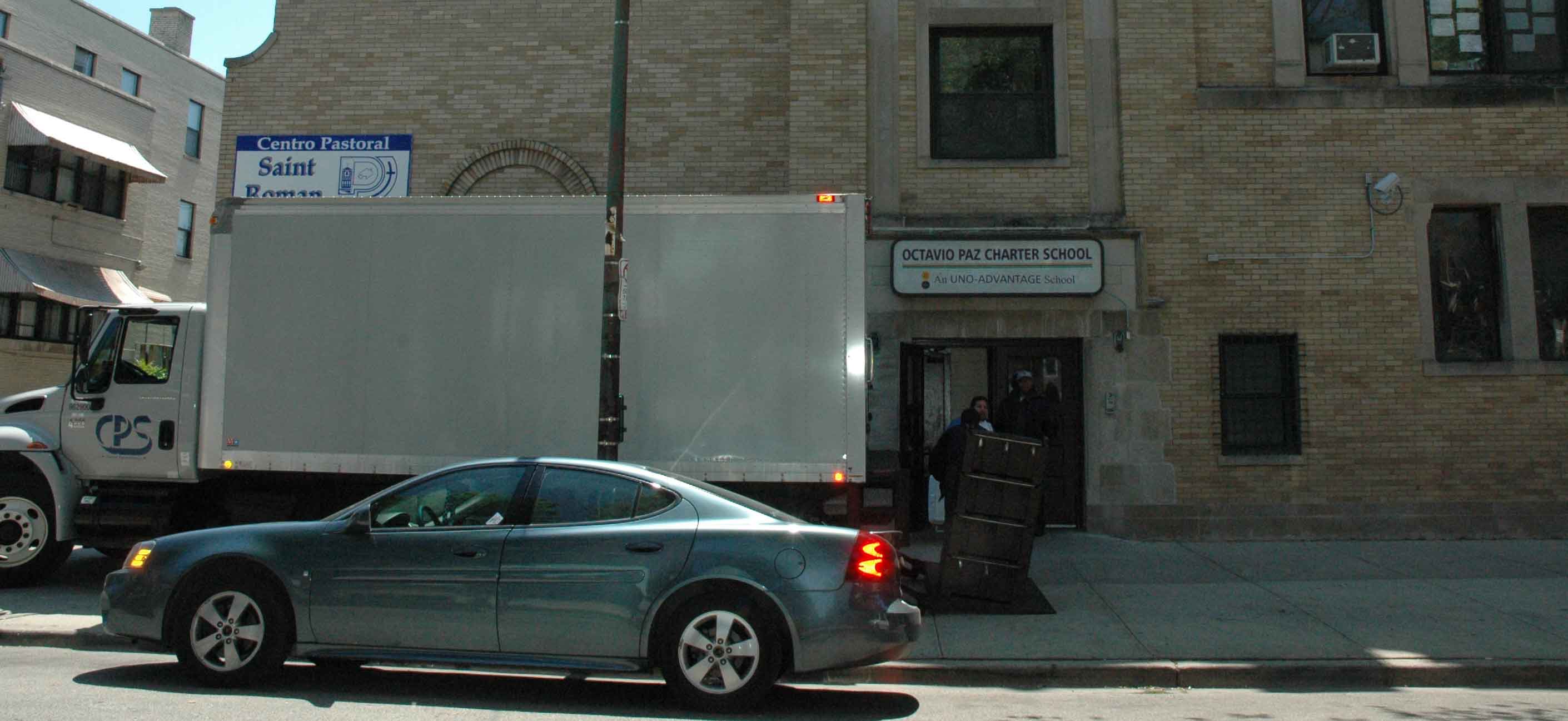 Despite the claims by CPS officials that the UNO Octavio Paz campus is unsafe, the fact is that most of Octavio Paz is a half block from the supposedly unsafe bell tower of St. Roman Catholic Church, and the church itself is holding services adjacent to the bell tower without any emergency evacuation. During the hearing, one speaker noted that CPS has falsified claims of "engineering problems" in the past to try and justify manipulation of school buildings and school land. Two notable examples have been Near North Career Magnet High School and Sabin Elementary School, both of which were supposedly "unsound" until a second opinion uncovered the fact that the first CPS opinion was simply untrue. A common joke at the executive offices of CPS is that CPS can get a "study" in one day to prove anything. Substance photo by George N. Schmidt.(Chicago is the only school district in Illinois that has a "Chief Executive Officer" rather than a superintendent because of a 1995 law that gave the city's mayor complete control over the third largest school system in the USA).
Despite the claims by CPS officials that the UNO Octavio Paz campus is unsafe, the fact is that most of Octavio Paz is a half block from the supposedly unsafe bell tower of St. Roman Catholic Church, and the church itself is holding services adjacent to the bell tower without any emergency evacuation. During the hearing, one speaker noted that CPS has falsified claims of "engineering problems" in the past to try and justify manipulation of school buildings and school land. Two notable examples have been Near North Career Magnet High School and Sabin Elementary School, both of which were supposedly "unsound" until a second opinion uncovered the fact that the first CPS opinion was simply untrue. A common joke at the executive offices of CPS is that CPS can get a "study" in one day to prove anything. Substance photo by George N. Schmidt.(Chicago is the only school district in Illinois that has a "Chief Executive Officer" rather than a superintendent because of a 1995 law that gave the city's mayor complete control over the third largest school system in the USA).
Duncan proposed a large number of school closings and reorganization in January 2008, and despite massive protests from people across the city, the Chicago Board of Education approved his proposals at its meeting on February 27, 2008. Most of the schools on what critics had begun calling Duncan's annual "Hit List" were closed in June 2008, but De La Cruz got a one-year reprieve, not closing until June 2009.
By January 2009, Duncan had created another 'Hit List' consisting of 22 schools, but by then he had been appointed U.S. Secretary of Education, so the job of closing the schools and defending the process fell to newly installed Chief Executive Officer Ron Huberman. Huberman, like Duncan, was appointed by Chicago Mayor Richard M. Daley. In both 2008 and 2009, parents, teacher and community members protested the closing of the school, which had won a Spotlight Award from the Illinois State Board of Education for educational success with low-income students. In February 2009, Huberman announced that he was reducing the Hit List from 22 to 16, drawing thanks from some people. Others, however, noted that CPS may have wanted to close only the 16 schools on the final list, expanding that list to 22 so that protesters could have some kind of "victory" while the use of the HIt List continued into the years of the Huberman administration.
'No charter school in De La Cruz building' — CPS claimed until it had destroyed De la Cruz
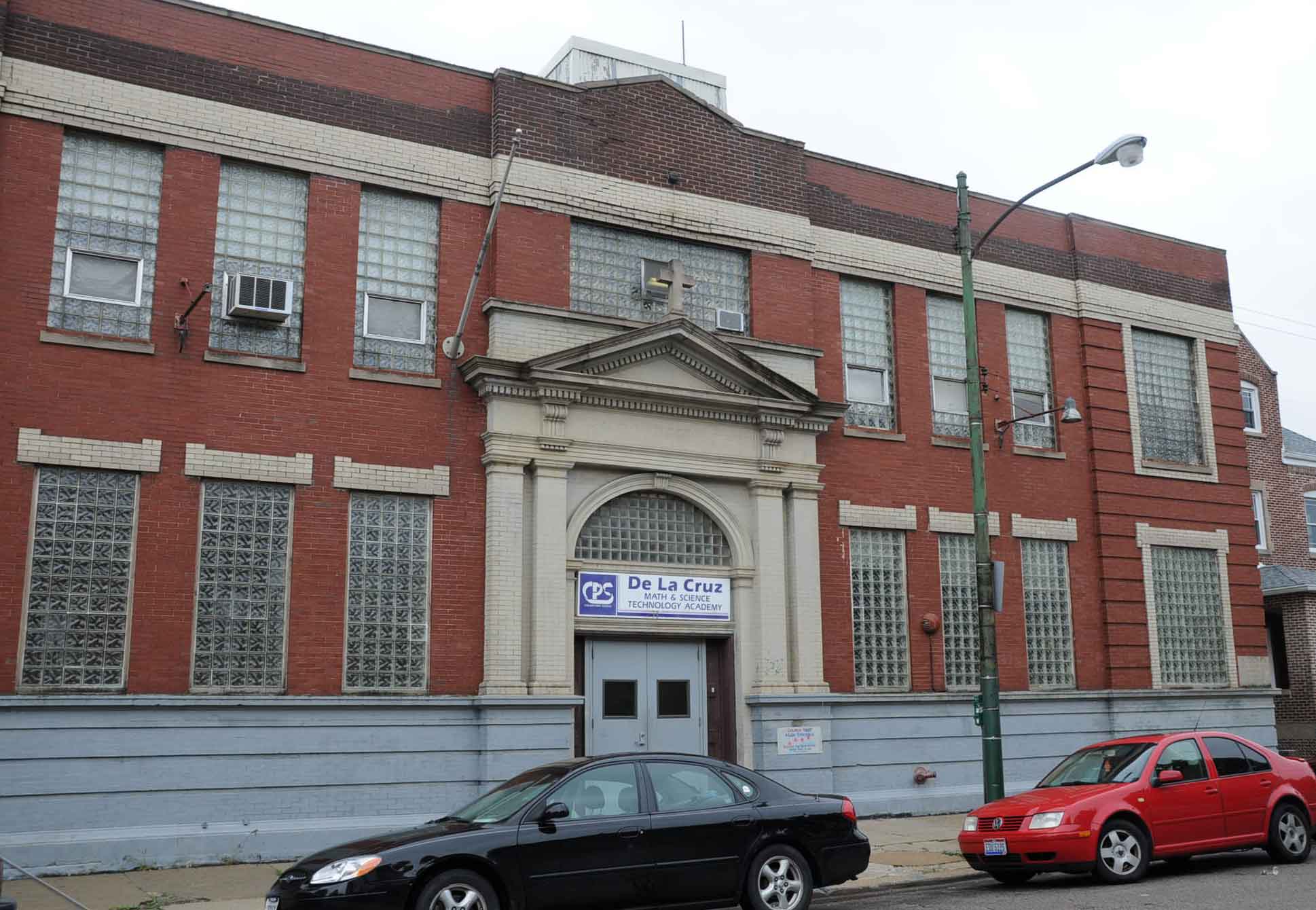 Skeptics noted that CPS claimed that De La Cruz Middle School (above) was both "underutilized" and slated for "demolition" prior to its being closed as a regular public school in June 2009. Critics noted that CPS continued to spend money to repair the De La Cruz building (above, at 2317 W. 23rd Place) up to the minute that the last teachers and supplies were moved out of the building in mid-June 2009. Most community activists, parents, and teachers knew that CPS officials were lying and that the De La Cruz site had been promised to the politically powerful UNO during the year that De La Cruz was fighting for its life. Substance photo by George N. Schmidt.Over the ensuing 20 or 21 months (between January 2008 and August 2009) following the first announcement that CPS would close De la Cruz Middle School despite its recognized record of success, CPS officials promised that there were no plans to open a charter school in the De la Cruz building. The claim was always that the Chicago Board of Education had to be efficient in its utilization of facilities, and that their particular kind of efficiency required the closing of schools year after year. De la Cruz was simply one example of good business-style management.
Skeptics noted that CPS claimed that De La Cruz Middle School (above) was both "underutilized" and slated for "demolition" prior to its being closed as a regular public school in June 2009. Critics noted that CPS continued to spend money to repair the De La Cruz building (above, at 2317 W. 23rd Place) up to the minute that the last teachers and supplies were moved out of the building in mid-June 2009. Most community activists, parents, and teachers knew that CPS officials were lying and that the De La Cruz site had been promised to the politically powerful UNO during the year that De La Cruz was fighting for its life. Substance photo by George N. Schmidt.Over the ensuing 20 or 21 months (between January 2008 and August 2009) following the first announcement that CPS would close De la Cruz Middle School despite its recognized record of success, CPS officials promised that there were no plans to open a charter school in the De la Cruz building. The claim was always that the Chicago Board of Education had to be efficient in its utilization of facilities, and that their particular kind of efficiency required the closing of schools year after year. De la Cruz was simply one example of good business-style management.
But as a growing number of critics noted, the business model constantly operated against the public schools and in favor of charter schools.
The contrast between the official CPS policy of "small schools" and the reality of CPS closing schools with low enrollment because of what was called "underutilization" has come up again and again during hearings and public discussions on the annual Hit Lists. CPS officials and the seven members of the Board of Education (who vote to approve the closings of the public schools and the subsequent awarding of the buildings to charter schools) have ignored the huge contradiction. During June 200 — the month CPS closed De la Cruz, South Chicago Elementary, and other public schools with relatively small enrollments — more than a dozen of the city's charter schools and so-called "campuses" had enrollments much smaller than De la Cruz, South Chicago, and the other true public schools that had been axed. De la Cruz was not the only viable neighborhood public schools destroyed by the "underutilization" policy during the Duncan years, only the best organized and most articulate in its opposition. For a year and a half, the official CPS line was that De la Cruz would probably be shuttered and demolished. Considering the claim that De La Cruz was going to be demolished, the behavior of CPS was certainly suspicious. According to De la Cruz teacher Kristine Mayle (and others who worked at the school), building renovations such as a new phone system, new windows, and new lighting ballasts and other reparis, were ongoing before the school was shuttered in June 2009. Mayle reported at the August 22, 2009 hearing, that the school's basement had a water leak that staff had tried to convince the Board to repair for years. After heavy rainfalls, the De la Cruz staff would arrive at work to find more than two inches of water in the building's basement, with noisy pumps operating to clear it out. No repair was ever done on the basement — until workers arrived to repair it on the very day the school closed down in June 2009, Mayle said.
The 'emergency' to give De La Cruz to UNO
The De la Cruz situation was not the only one in the community. For years, parents, students, teachers, and community leaders at Whittier Elementary School had also been protesting the refusal of the Board of Education to fix their public school. Then, in a hastily organized meeting held on Friday, August 21, 2009, at St. Augustine College in Little Village, CPS announced plans to locate UNO Charter-Octavio Paz Primary and Intermediate Campuses to the De la Cruz building for the 2009-2010 school year. The pretext was the “emergency” situation due to “structural issues” at their current site, St. Roman Church. By late August 2009, CPS was claiming that it plans to “temporarily house” Octavio Paz at De la Cruz for one year only.
Everything about this deal looked very suspicious, according to Pilsen residents and teachers in the already existing neighborhood schools. First, the Board of Education timed the announcement of the proposal to coincide with the week when school principals customarily take their vacations. CPS did not inform any of the principals of the neighborhood schools about the proposal or the community meeting. The “public notice” of the meeting was published in the Sun Times only five days before the meeting, and in “Hoy” a mere three days before the meeting. Principals, staffs and parents of the nearby neighborhood schools for the most part knew nothing about plans to locate a charter elementary school in their neighborhood.
Despite the failure of CPS to inform the community, community leaders, teachers, and others worked hard during the third week of August 2009 to bring people to the meeting. The few neighborhood activists who did learn about this latest UNO land grab were met by more than 150 UNO parents and children at the August 21 meeting. UNO's Executive Director Juan Rangel, his staff, and the teachers from UNO Octavio Paz (a non-union school) had organized the UNO parents, whose children attend UNO-Octavio Paz Charter School, to come out in droves to the hearing.
The actual meeting on August 21 didn't begin until after 6:15 p.m. because of the large crowd trying to get in an to sign in to speak. Although those who arrived early had mostly been organized by UNO and were ready to cheer and speak in support of the "emergency" move, most of those who arrived later came from the community and opposed the move for a variety of reasons.
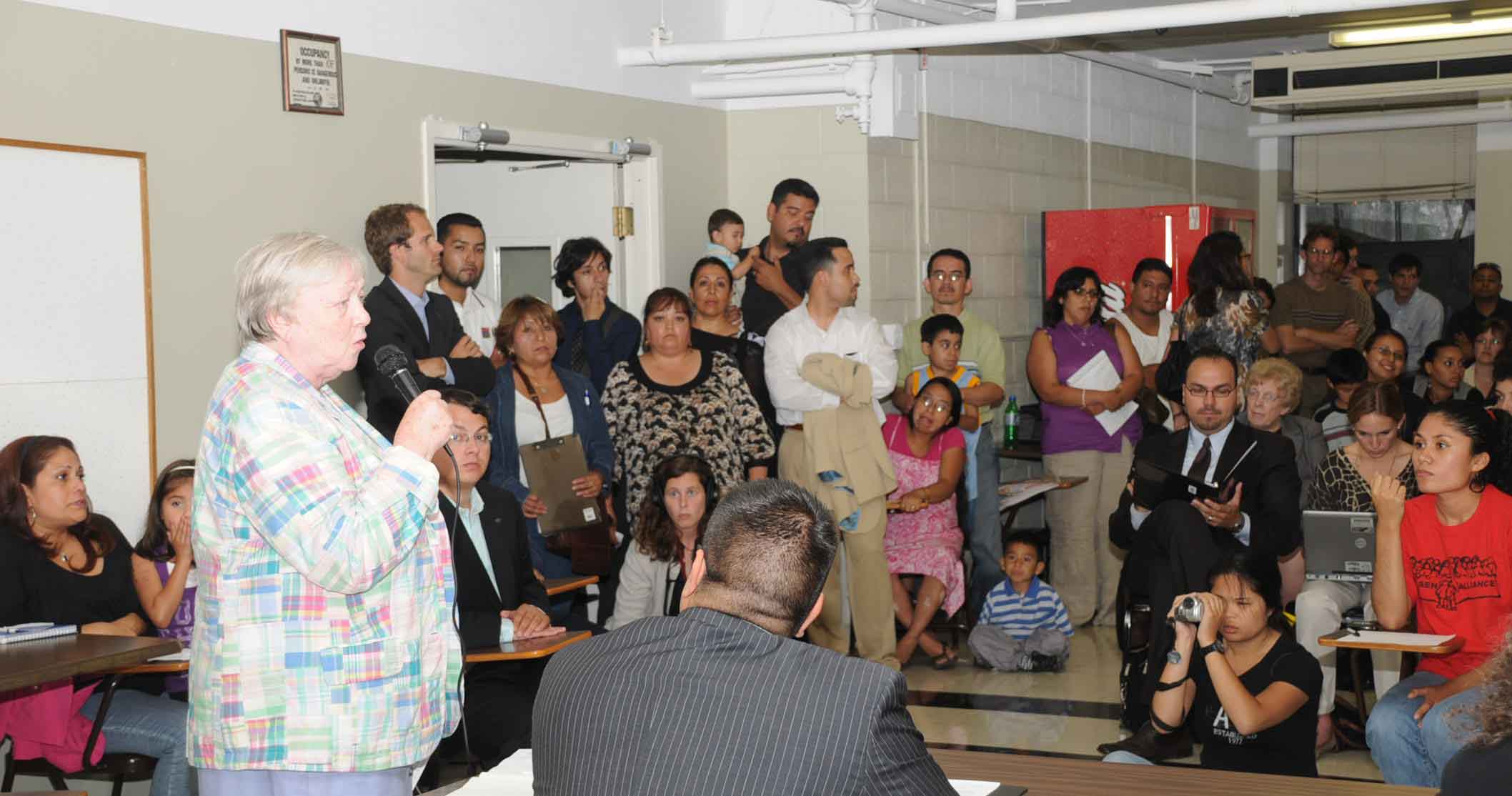 One of the first people to speak in favor of the UNO move into the De la Cruz building was Sister Barbara McCarry (above, holding microphone), who said that she was a Catholic nun. Sister McCarry told the crowd that she had begun her career in public education by working at the CPS Office of New Schools, but had then taken a job at UNO, where she is now director of curriculum for the UNO charter schools network. Sister McCarry spoke in favor of the move of UNO to the De la Cruz building. Substance photo by George N. Schmidt.When the majority of people were finally seated in the large room, the number (including children) totaling more than 200, the hearing officer finally called the meeting to order.
One of the first people to speak in favor of the UNO move into the De la Cruz building was Sister Barbara McCarry (above, holding microphone), who said that she was a Catholic nun. Sister McCarry told the crowd that she had begun her career in public education by working at the CPS Office of New Schools, but had then taken a job at UNO, where she is now director of curriculum for the UNO charter schools network. Sister McCarry spoke in favor of the move of UNO to the De la Cruz building. Substance photo by George N. Schmidt.When the majority of people were finally seated in the large room, the number (including children) totaling more than 200, the hearing officer finally called the meeting to order.
The first speaker was from the Board, Jaime Guzman of the Office of New Schools. Guzman told the meeting that he was representing Ron Huberman, CPS CEO, and that CPS was in support of the UNO proposal, given the emergency.
Guzman was immediately followed by UNO Executive Director Juan Rangal, who was given more than five minutes to speak by the hearing officer. Previously the hearing officer had warned the meeting that because of the large number of speakers each speaker would be limited to two minutes and that the limitation on speakers would be strictly enforced. The hearing officer broke his rule (to be reinstated later, for critics of UNO) on the first speaker, allowing Rangal not only to speak at length, but to periocially pause at applause lines in his remarks.
Others speak in favor of UNO plan
One of the first people to speak in favor of the UNO move into the De la Cruz building was Sister Barbara McCarry, who said that she was a Catholic nun. Sister McCarry told the crowd that she had begun her career in public education by working at the CPS Office of New Schools, but had then taken a job at UNO, where she is now director of curriculum for the UNO charter schools network. Sister McCarry spoke in favor of the move of UNO to the De la Cruz building. She contrasted the UNO charter schools with the public schools, saying that families chose the UNO schools because they had discipline, including school uniforms, unlike the public schools. She said that many in the community were looking for something like the Catholic schools, and that UNO was providing that to the community.
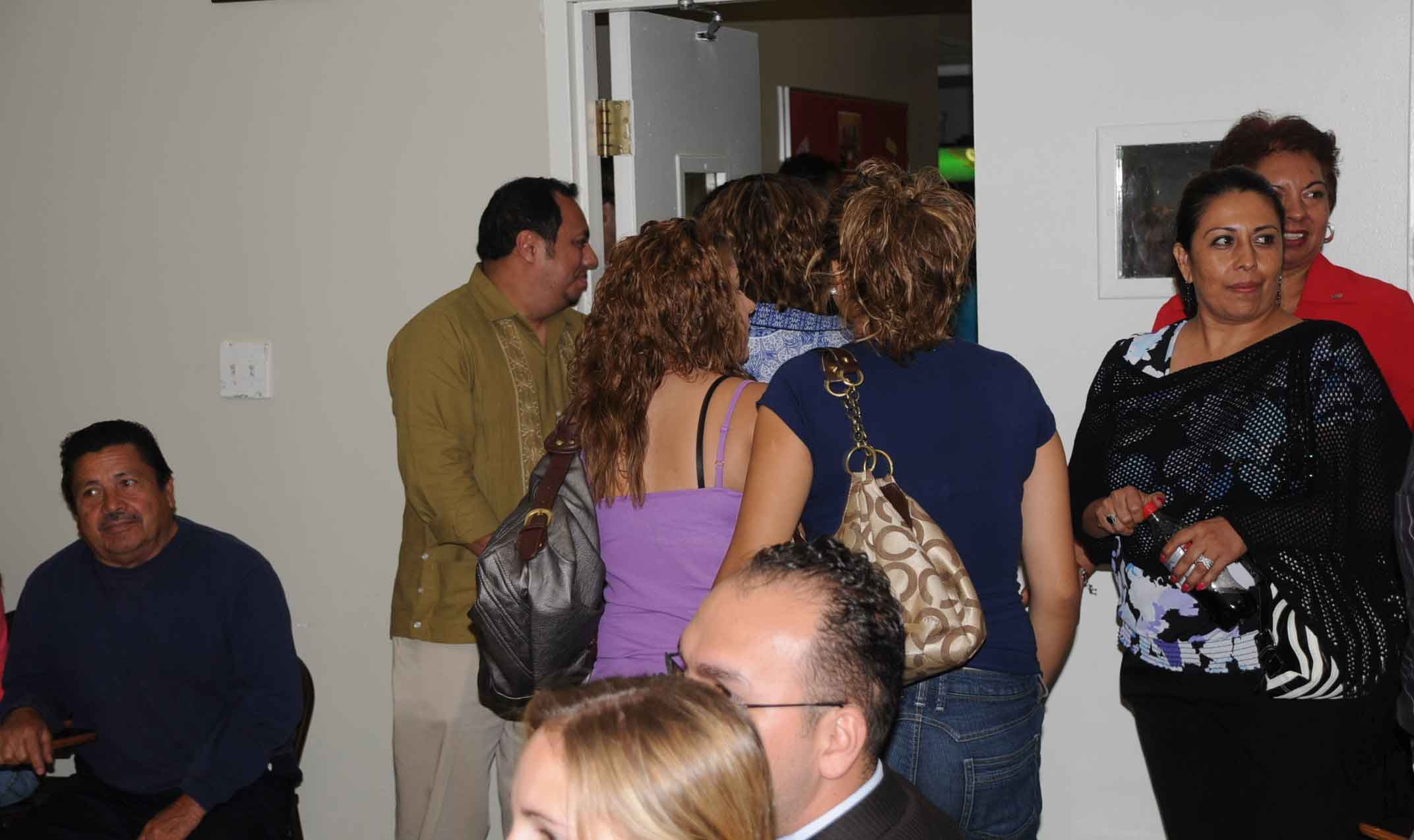 Although the meeting was supposed to continue until after all those who signed up to speak were heard, more than a half hour before the meeting was to end the UNO leadership signaled and the large contingent in support of UNO began to stand up and leave en masse while Whittier Elementary School Teacher Norine Gutekanst took the microphone to speak. Gutekanst was forced to wait five minutes while the slow procession existed the room, each of those leaving being thanked by UNO Executive Director Juan Rangel (above at the door as UNO leaves). Substance photo by George N. Schmidt.A small number of parents who said their children attended the UNO charter schools also spoke, although a larger number of the people who signed up either said they would not speak or, when the names were called, were not even in the room. At times, the hearing officer had to call two or three names before someone answered and moved to the front of the room to speak.
Although the meeting was supposed to continue until after all those who signed up to speak were heard, more than a half hour before the meeting was to end the UNO leadership signaled and the large contingent in support of UNO began to stand up and leave en masse while Whittier Elementary School Teacher Norine Gutekanst took the microphone to speak. Gutekanst was forced to wait five minutes while the slow procession existed the room, each of those leaving being thanked by UNO Executive Director Juan Rangel (above at the door as UNO leaves). Substance photo by George N. Schmidt.A small number of parents who said their children attended the UNO charter schools also spoke, although a larger number of the people who signed up either said they would not speak or, when the names were called, were not even in the room. At times, the hearing officer had to call two or three names before someone answered and moved to the front of the room to speak.
The supporters of UNO's proposals were large in number, but they may not have even been the majority in the room. As the evening continued, there were more and more speakers challenging the UNO proposal.
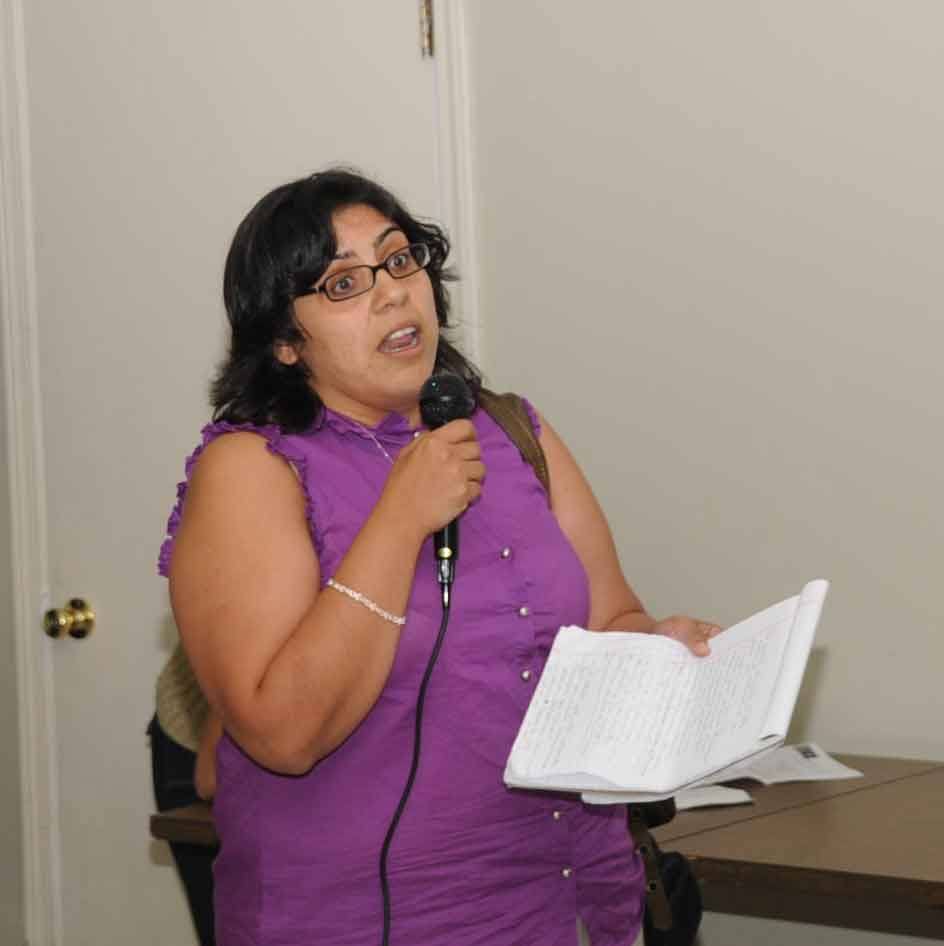 Gema Gaete (above) asked how could it be that UNO does not have the money to repair their Octavio Paz school, given the millions in state money that UNO had been awarded in June. In late June 2009, according to press reports, UNO was awarded $98 million by Illinois Governor Pat Quinn to double its number of charters to 16 schools in the coming years. The previous April, UNO had released a study arguing for state money to relieve school overcrowding on the northwest and southwest sides. Instead of repairing existing public schools in Chicago, Quinn has promoted the privatization alternative. Substance photo by George N. Schmidt.Alejandra Ibanez, Exec Director of Pilsen Alliance, questioned why UNO's Octavio Paz school was being located in Pilsen, where neighborhood schools have experienced steadily falling enrollment. She asked why it wasn't being located in other areas of the city, where schools are overcrowded and have real capacity needs.
Gema Gaete (above) asked how could it be that UNO does not have the money to repair their Octavio Paz school, given the millions in state money that UNO had been awarded in June. In late June 2009, according to press reports, UNO was awarded $98 million by Illinois Governor Pat Quinn to double its number of charters to 16 schools in the coming years. The previous April, UNO had released a study arguing for state money to relieve school overcrowding on the northwest and southwest sides. Instead of repairing existing public schools in Chicago, Quinn has promoted the privatization alternative. Substance photo by George N. Schmidt.Alejandra Ibanez, Exec Director of Pilsen Alliance, questioned why UNO's Octavio Paz school was being located in Pilsen, where neighborhood schools have experienced steadily falling enrollment. She asked why it wasn't being located in other areas of the city, where schools are overcrowded and have real capacity needs.
Expanding UNO charters at the expense of regular public schools — and community opposition — dates back years
The Pilsen Alliance's Alejandra Ibanez was reflecting a critique of the expansion of the UNO charter schools that began more than four years ago. In early 2006, Arne Duncan was CEO of CPS and beginning the most favored status still being received by charter schools. Duncan was supported at the time by Board of Education President Michael Scott, who left the Board of a time, returning in February 2009 after Mayor Daley axed Rufus Williams.
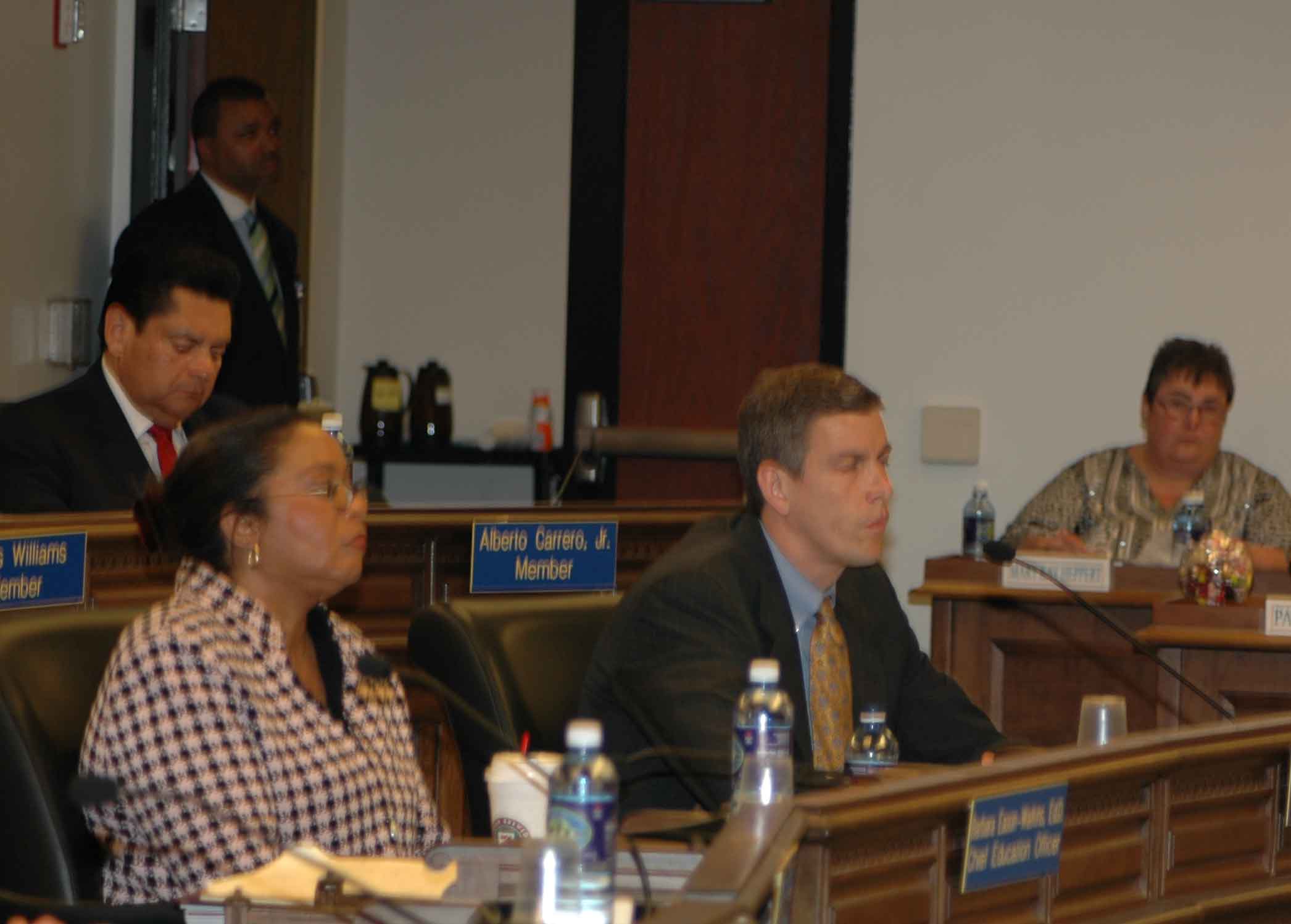 During the protests by Pilsen parents at the April 22, 2006, meeting of the Chicago Board of Education, then CEO Arne Duncan closed his eyes in irritation about the large scale opposition to his proposal that the UNO charter schools be allowed to expand under the pretext of "relieving overcrowding" on Chicago's southwest side. Speaker after speaker stated that the community wanted its public schools to be repaired, with new public schools created where needed because of overcrowding — not additional charter schools. Despite the facts, including the fact that the schools of Pilsen itself were no longer overcrowded, Duncan kept his proposal to create the UNO "Las Casas campus" in the heart of Pilsen, and the seven-member Board of Education passed the Board Report that day. Substance archive photo from the April 2006 Board meeting by George N. Schmidt.When Duncan first proposed that the UNO charter schools be allowed to open the branch ("campus") currently in Pilsen, there was a massive outcry from the people of Pilsen. Residents, parents, principals, and teachers pointed out that for the first time in generations, the schools of Pilsen were not overcrowded. They isnisted that Pilsen needed more and more resources for its existing public schools — not an UNO charter school on the pretext of "relieving overcrowding." The Board tried to spin the issue, finally ignoring the majority and pretending there were two "sides" on the question, even though the "side" the Board was on was largely a powerful but artificial creation of corporate dollars, in 2006 and through 2009. As early as May 2006, Substance reported on Duncan's plan to expand the UNO charter schools under the pretext that they would "relieve overcrowding" — and on the community's response to that plan. August 2009 was not the first time that the CPS "Office of New Schools" had held virtually secret "hearings" on the expansion of the UNO charter schools in the Pilsen / Little Village communities. One of the earlest on record happened in May 2006, at the time most of the residents of the communities were pre-occupied with the massive immigrant rights marches that took place in March and May 2006.
During the protests by Pilsen parents at the April 22, 2006, meeting of the Chicago Board of Education, then CEO Arne Duncan closed his eyes in irritation about the large scale opposition to his proposal that the UNO charter schools be allowed to expand under the pretext of "relieving overcrowding" on Chicago's southwest side. Speaker after speaker stated that the community wanted its public schools to be repaired, with new public schools created where needed because of overcrowding — not additional charter schools. Despite the facts, including the fact that the schools of Pilsen itself were no longer overcrowded, Duncan kept his proposal to create the UNO "Las Casas campus" in the heart of Pilsen, and the seven-member Board of Education passed the Board Report that day. Substance archive photo from the April 2006 Board meeting by George N. Schmidt.When Duncan first proposed that the UNO charter schools be allowed to open the branch ("campus") currently in Pilsen, there was a massive outcry from the people of Pilsen. Residents, parents, principals, and teachers pointed out that for the first time in generations, the schools of Pilsen were not overcrowded. They isnisted that Pilsen needed more and more resources for its existing public schools — not an UNO charter school on the pretext of "relieving overcrowding." The Board tried to spin the issue, finally ignoring the majority and pretending there were two "sides" on the question, even though the "side" the Board was on was largely a powerful but artificial creation of corporate dollars, in 2006 and through 2009. As early as May 2006, Substance reported on Duncan's plan to expand the UNO charter schools under the pretext that they would "relieve overcrowding" — and on the community's response to that plan. August 2009 was not the first time that the CPS "Office of New Schools" had held virtually secret "hearings" on the expansion of the UNO charter schools in the Pilsen / Little Village communities. One of the earlest on record happened in May 2006, at the time most of the residents of the communities were pre-occupied with the massive immigrant rights marches that took place in March and May 2006.
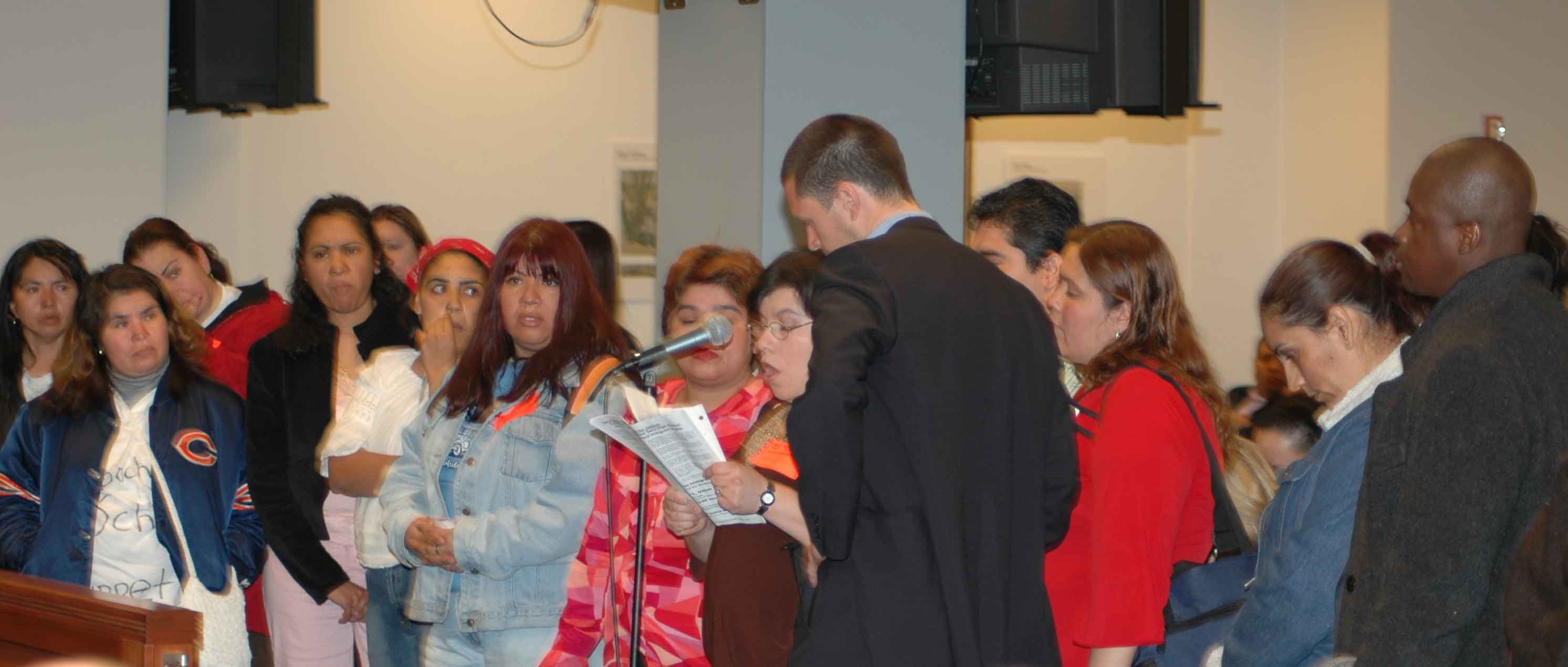 Parents and others from the Pilsen community asked the Board of Education at its April 2006 meeting to vote against the proposal brought by Arne Duncan that UNO be allowed to create a charter school "campus" in Pilsen to "relieve overcrowding." Despite widespread opposition to the charter school expansion from a broad range of citizens (including both public and Catholic school leaders and principals) the "Renaissance 2010" program expanding charter schools was approved. Substance archive photo taken during the April 2006 meeting of the Chicago Board of Education by George N. Schmidt. "Pastor Charles Dahm of St Pius Church — representing three other Catholic schools — spoke next," [during public participation at the April 22, 2006 Chicago Board of Education meeting], Substance reporter Lotty Blumenthal reported at the time in the May 2006 Substance. "Like the previous speaker, he said the surrounding schools of this new charter are not overcrowded and have had declining enrollment for the past five years. The length of decline should have been noticed. The Pastor had written letters from the three Catholic school principals saying they were against this charter. He had written copies of CPS’ own statistics showing a decline in enrollment for five years. He had a letter signed by 15 school principals in this area saying that they had not been notified about hearings on the matter, as well as other community organization people. Any hearing held had not placed a public notice, which he felt might be against the law. He begged and implored that the Board change the location."
Parents and others from the Pilsen community asked the Board of Education at its April 2006 meeting to vote against the proposal brought by Arne Duncan that UNO be allowed to create a charter school "campus" in Pilsen to "relieve overcrowding." Despite widespread opposition to the charter school expansion from a broad range of citizens (including both public and Catholic school leaders and principals) the "Renaissance 2010" program expanding charter schools was approved. Substance archive photo taken during the April 2006 meeting of the Chicago Board of Education by George N. Schmidt. "Pastor Charles Dahm of St Pius Church — representing three other Catholic schools — spoke next," [during public participation at the April 22, 2006 Chicago Board of Education meeting], Substance reporter Lotty Blumenthal reported at the time in the May 2006 Substance. "Like the previous speaker, he said the surrounding schools of this new charter are not overcrowded and have had declining enrollment for the past five years. The length of decline should have been noticed. The Pastor had written letters from the three Catholic school principals saying they were against this charter. He had written copies of CPS’ own statistics showing a decline in enrollment for five years. He had a letter signed by 15 school principals in this area saying that they had not been notified about hearings on the matter, as well as other community organization people. Any hearing held had not placed a public notice, which he felt might be against the law. He begged and implored that the Board change the location."
[The complete May 2006 issue of Substance is available at the "old" Substance website at www.substancnews.com. Because of the tight budget of Substance, we maintain the "old" site, but because of software needs have surpassed it with the site at www.substancenews.net, which has been updated daily since January 2009].
Despite the facts and the opposition of the majority of the community, the Chicago Board of Education, according to the Board Agenda of Action for April 22, 2006, approved Arne Duncan's recommendation to expand the UNO charter schools to "relieve overcrowding."
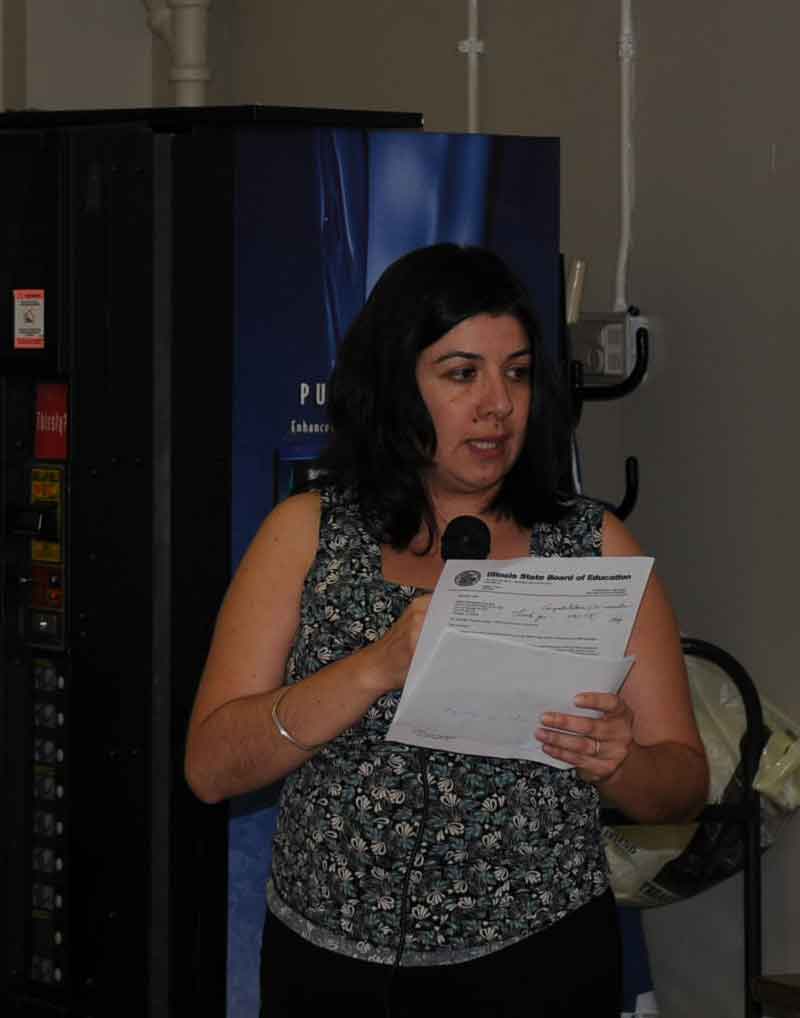 Alejandra Ibañez (above), Executive Director of Pilsen Alliance, questioned why UNO's Octavio Paz school was being located in Pilsen, where neighborhood schools have experienced steadily falling enrollment. While parents, teachers, students and community leaders from Pilsen have been asking CPS to repair and upgrade existing public schools within Pilsen, CPS has been ignoring the conditions and promoting the charter schools instead. Substance photo by George N. Schmidt.The UNO Las Casas "campus" at 1641 W. 16th St. was established. After that, Duncan and the Board supported the expansion of the UNO charter school "campuses" across the southwest side, on the pretext of "relieving overcrowding," while CPS was manipulating its capital development budget in a way that increased the overcrowding at the neighborhood schools south and west of Pilsen (while the schools in Pilsen itself continued to be not overcrowded). At the August 21, 2009 meeting at St. Augustine's, other community speakers questioned Rangel's assertion that UNO did not have the money to make repairs to the St. Roman School, where UNO's Octavio Paz Primary School is now housed.
Alejandra Ibañez (above), Executive Director of Pilsen Alliance, questioned why UNO's Octavio Paz school was being located in Pilsen, where neighborhood schools have experienced steadily falling enrollment. While parents, teachers, students and community leaders from Pilsen have been asking CPS to repair and upgrade existing public schools within Pilsen, CPS has been ignoring the conditions and promoting the charter schools instead. Substance photo by George N. Schmidt.The UNO Las Casas "campus" at 1641 W. 16th St. was established. After that, Duncan and the Board supported the expansion of the UNO charter school "campuses" across the southwest side, on the pretext of "relieving overcrowding," while CPS was manipulating its capital development budget in a way that increased the overcrowding at the neighborhood schools south and west of Pilsen (while the schools in Pilsen itself continued to be not overcrowded). At the August 21, 2009 meeting at St. Augustine's, other community speakers questioned Rangel's assertion that UNO did not have the money to make repairs to the St. Roman School, where UNO's Octavio Paz Primary School is now housed.
Gema Gaete asked how could it be that UNO does not have the money to repair their school, given the millions in state money that UNO had been awarded in June. In late June 2009, UNO was awarded $98 million by Illinois Governor Pat Quinn to double its number of charters to 16 schools. The previous April, UNO had released a study arguing for state money to relieve school overcrowding on the northwest and southwest sides.
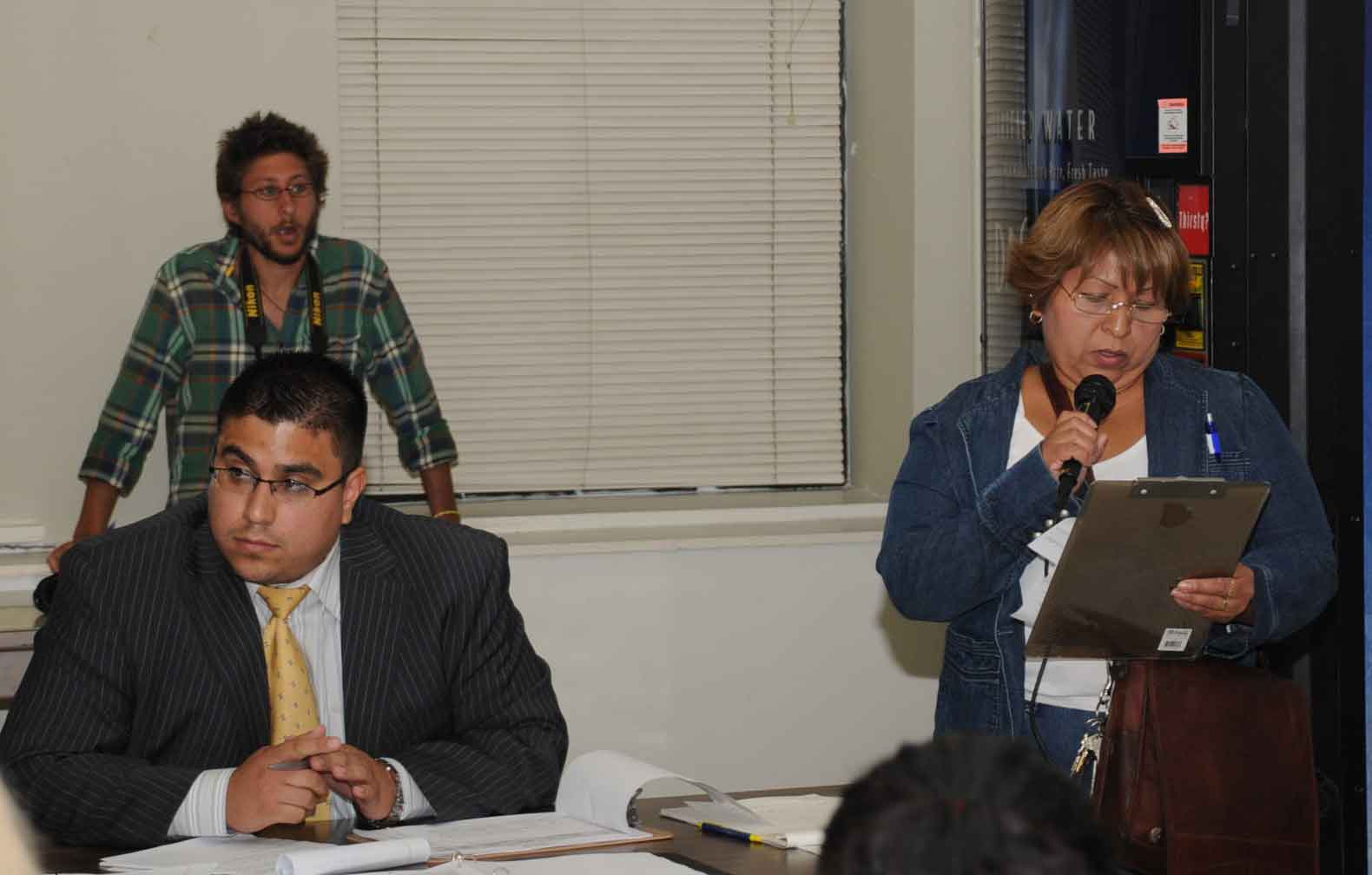 Parents from Whittier Elementary spoke against putting the charter school four blocks from Whittier. Virginia Guevara, president of the Whittier LSC (above, right), spoke about how Whittier's parents have been asking for years for building repairs and an extension at Whittier to remediate substandard physical conditions in the school, and have been virtually ignored. On rainy days, the playlot on the west side of Whittier fills with so much water that it becomes dangerous, and the hundred year old school could use extensive repairs. Whenever Whittier has gone to the Board of Education meetings of facilities hearings to document its problems, however, CPS officials have claimed that there is no money for Whittier. Substance photo by George N. Schmidt. Parents from Whittier Elementary spoke against putting the charter school four blocks from Whittier. Virginia Guevara, president of the Whittier LSC, spoke about how Whittier's parents have been asking for years for building repairs and an extension at Whittier to remediate substandard physical conditions in the school, and have been virtually ignored.
Parents from Whittier Elementary spoke against putting the charter school four blocks from Whittier. Virginia Guevara, president of the Whittier LSC (above, right), spoke about how Whittier's parents have been asking for years for building repairs and an extension at Whittier to remediate substandard physical conditions in the school, and have been virtually ignored. On rainy days, the playlot on the west side of Whittier fills with so much water that it becomes dangerous, and the hundred year old school could use extensive repairs. Whenever Whittier has gone to the Board of Education meetings of facilities hearings to document its problems, however, CPS officials have claimed that there is no money for Whittier. Substance photo by George N. Schmidt. Parents from Whittier Elementary spoke against putting the charter school four blocks from Whittier. Virginia Guevara, president of the Whittier LSC, spoke about how Whittier's parents have been asking for years for building repairs and an extension at Whittier to remediate substandard physical conditions in the school, and have been virtually ignored.
Whittier parent Rosa Guzman asked CPS why Pilsen parents weren't asked what kind of school they wanted in the community. She went on to say that Whittier parents want schools that allow students to maintain their native language as they acquire English [UNO schools are firmly English-only]. Furthermore, she opposed the UNO school in the neighborhood because, she said, Pilsen doesn't need another K-8 school.
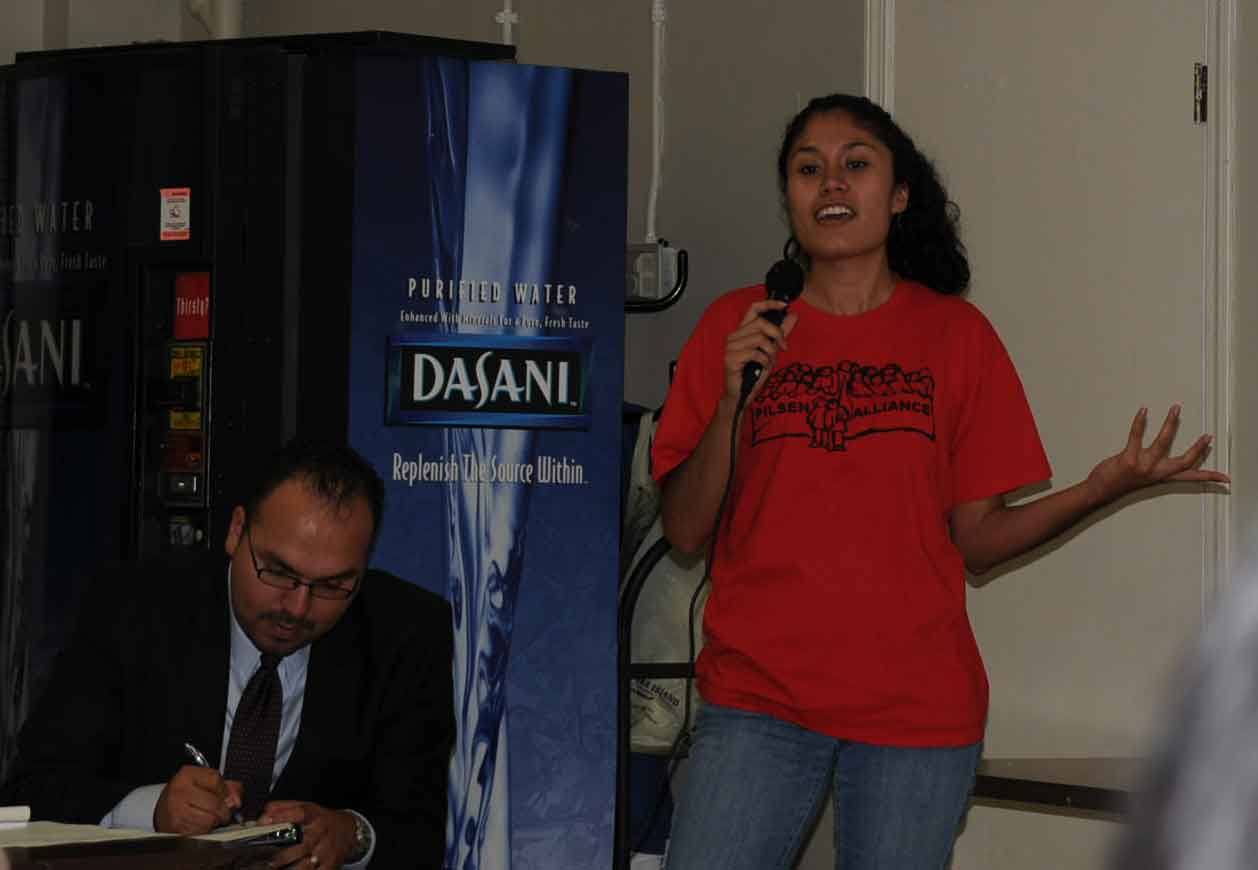 Proudly wearing her Pilsen Alliance tee shirt, Little Village resident Lisette Casillas, a graduate of Farragut High School, recalled how her school was always struggling for resources, including items as simple as textbooks for all students. Opposing the charter, she said that there are good teachers in CPS and they need just need the resources and money to provide a good education. She also objected fiercely to the UNO parents' claims that their children are unsafe in regular public schools because of gang problems. "I'm not a gang banger," she said, mocking the claims. "My brothers are not gang bangers..." she said. challenging the stereotype, promoted by UNO, that children are not safe in regular public schools, but will be safe in charter schools. What the charter school advocates leave out of the narrative is that all of Chicago's charter schools — including the UNO charters — kick out suspected gang members, sending them back to the regular public schools. Substance photo by George N. Schmidt.Little Village resident Lisette Casillas, a graduate of Farragut High, recalled how her school was always struggling for resources. Opposing the charter, she said that there are good teachers in CPS and they need just need the resources and money to provide a good education. Jim Vail, teacher at Hammond Elementary, a neighboring elementary school, asked the Board to get a second opinion on the structural condition of the St. Roman building. He cited the example from several years ago when CPS tried to close Sabin Elementary for structural reasons, and when a second opinion was solicited, the building was determined to be in good structural shape.
Proudly wearing her Pilsen Alliance tee shirt, Little Village resident Lisette Casillas, a graduate of Farragut High School, recalled how her school was always struggling for resources, including items as simple as textbooks for all students. Opposing the charter, she said that there are good teachers in CPS and they need just need the resources and money to provide a good education. She also objected fiercely to the UNO parents' claims that their children are unsafe in regular public schools because of gang problems. "I'm not a gang banger," she said, mocking the claims. "My brothers are not gang bangers..." she said. challenging the stereotype, promoted by UNO, that children are not safe in regular public schools, but will be safe in charter schools. What the charter school advocates leave out of the narrative is that all of Chicago's charter schools — including the UNO charters — kick out suspected gang members, sending them back to the regular public schools. Substance photo by George N. Schmidt.Little Village resident Lisette Casillas, a graduate of Farragut High, recalled how her school was always struggling for resources. Opposing the charter, she said that there are good teachers in CPS and they need just need the resources and money to provide a good education. Jim Vail, teacher at Hammond Elementary, a neighboring elementary school, asked the Board to get a second opinion on the structural condition of the St. Roman building. He cited the example from several years ago when CPS tried to close Sabin Elementary for structural reasons, and when a second opinion was solicited, the building was determined to be in good structural shape.
Pilsen resident Madeline Tovar asked why the community was not notified about the meeting, so that they could bring more residents. She stated her opposition to awarding UNO the De la Cruz building, and said it was “a done deal” with the approval of Alderman Danny Solis.
As the meeting drew to a close, CPS' Jaime Guzman announced that “De la Cruz remains unviable” as a longterm location for a school, and that CPS plans to put it up for sale. Residents have wonder if the plan all along has been to sell the building and land to UNO. Ms. Ibanez of Pilsen Alliance stated, “Parents, teachers and community residents are furious at CPS’ double standard in facilities planning; which schools get capital improvements, which don’t, which can stay open and which ones get closed. While many local neighborhood schools, such as Whittier, a feeder school to the former De La Cruz, have had to plead with CPS for capital improvements.... charter schools such as UNO seem to get blank checks.”
Was the "hearing" really a CPS hearing?
One question that became more and more puzzling to experienced observers as the evening of August 21 wore on was a simple one: was this "hearing" really a hearing?
Although the Chicago Public Schools was obviously paying for some things about the "hearing," the entire operation seemed to be done by the powerful CPS "Office of New Schools" and the school system's "Renaissance 2010" operation. The distinction between a Renaissance 2010 "hearing" and a CPS hearing is relevant.
For more than a year, the Office of New Schools has been hosting so-called "hearings" across Chicago on various aspects of the controversial Renaissance 2010 program.
During the August 21, 2009, hearing, Substance reporters noticed that the hearing officer did not seem to have a court reporter taking a full transcript of the hearing, a traditional requirement at CPS hearings. At the same time, Jaime Guzman, of the Office of New Schools, was sitting next to a young lady who was typing into a laptop computer, reprising every word in English that was said.
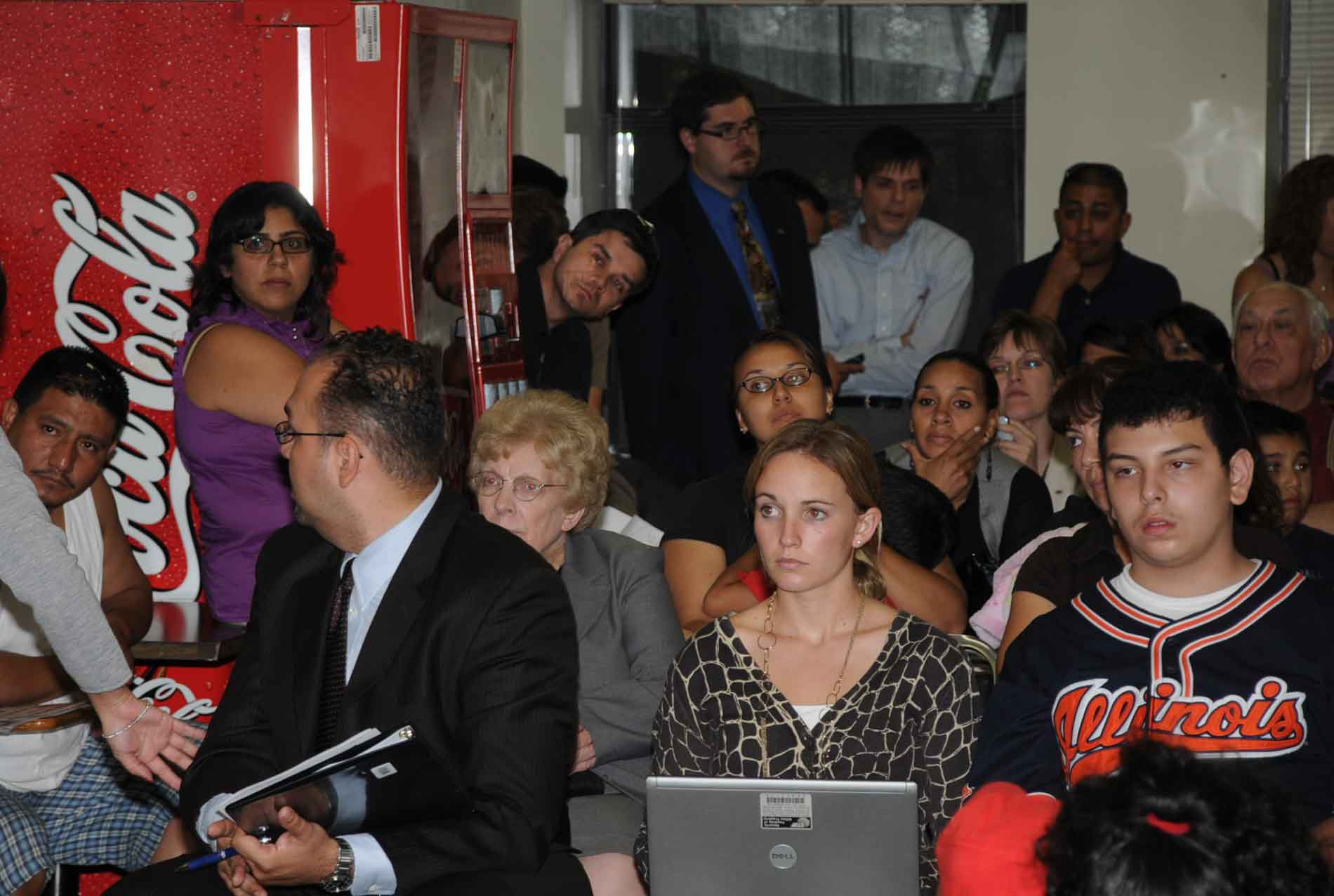 Office of New Schools executive Jaime Guzman (above, facing away from camera) sat beside the person designated by New Schools to take notes into a Chicago Board of Education laptop during the "hearing." When asked for a copy of the notes, Guzman told Substance they were a "draft." When asked for the identity of the CPS employee who was taking notes throughout the English language portions of the meeting, Guzman said she was an intern and that he did not know her name. The information matters because under the newly strengthened Illinois Freedom of Information Act (FOIA), the notes taken by an employee of CPS during a public meeting cannot be denied to the public. Community activists are considering major legal questions regarding the so-called "hearings" being hosted under the banner of "Renaissance 2010" as more and more Chicago public schools are being closed and the shuttered buildings quickly flipped to charter school operators. Substance photo by George N. Schmidt. But when Substance requested a copy of the report being prepared on the laptop, Guzman told Substance that the report was a "draft" and would not be available until the "final version" was reviewed. When asked who the typist was, Guzman said she was an intern at the Office of New Schools. When asked what the intern's name was, Guzman said he did not know.
Office of New Schools executive Jaime Guzman (above, facing away from camera) sat beside the person designated by New Schools to take notes into a Chicago Board of Education laptop during the "hearing." When asked for a copy of the notes, Guzman told Substance they were a "draft." When asked for the identity of the CPS employee who was taking notes throughout the English language portions of the meeting, Guzman said she was an intern and that he did not know her name. The information matters because under the newly strengthened Illinois Freedom of Information Act (FOIA), the notes taken by an employee of CPS during a public meeting cannot be denied to the public. Community activists are considering major legal questions regarding the so-called "hearings" being hosted under the banner of "Renaissance 2010" as more and more Chicago public schools are being closed and the shuttered buildings quickly flipped to charter school operators. Substance photo by George N. Schmidt. But when Substance requested a copy of the report being prepared on the laptop, Guzman told Substance that the report was a "draft" and would not be available until the "final version" was reviewed. When asked who the typist was, Guzman said she was an intern at the Office of New Schools. When asked what the intern's name was, Guzman said he did not know.
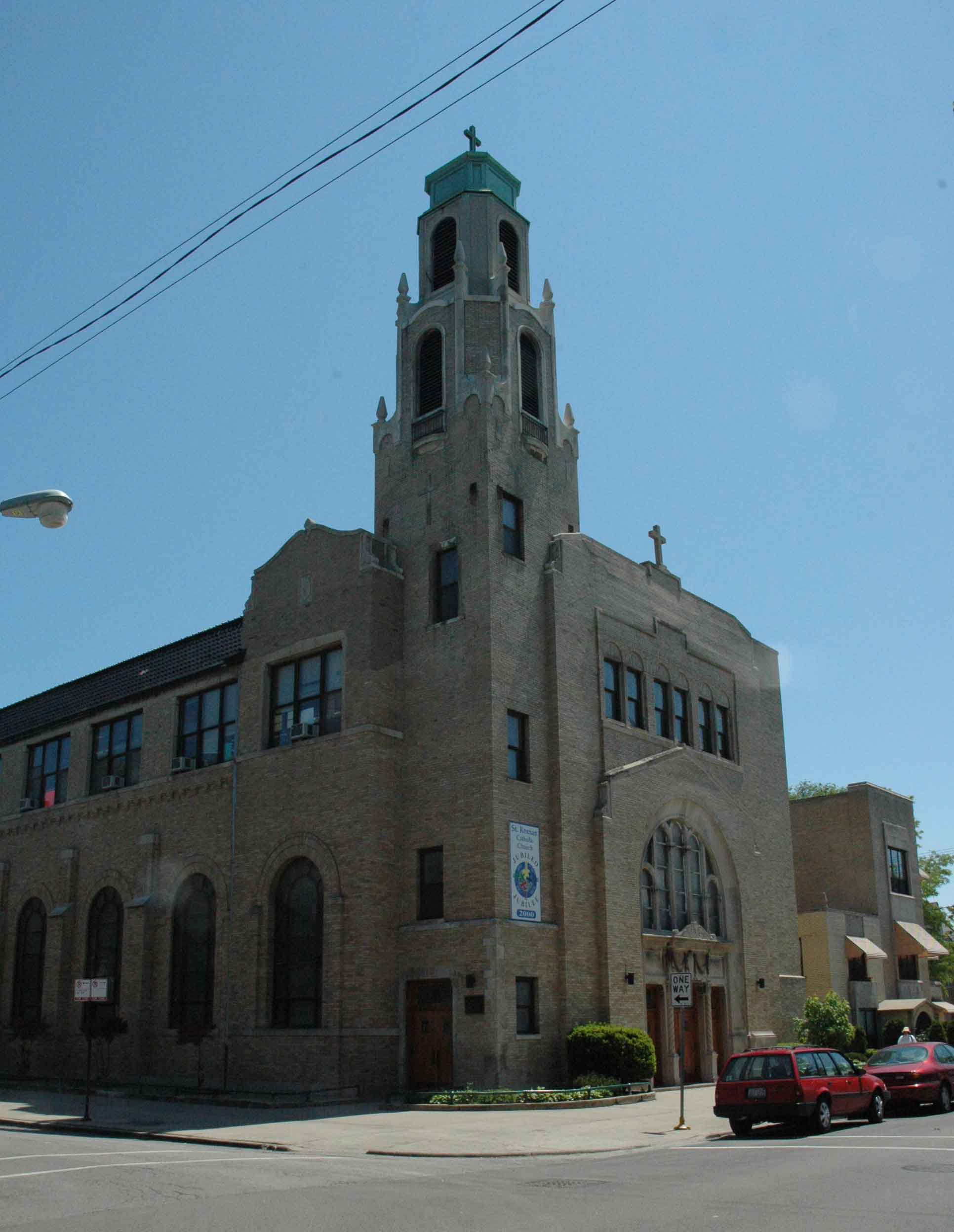 The St. Roman Catholic Church at 25th and Washtenaw in Chicago continued to hold regular services in August 2009, despite claims from CPS officials and UNO that the building had become unsafe because of problems with the church bell tower (above). The above photo was taken in May 2007, when UNO's Octavio Paz charter school was already in operation in the St. Roman school building, which extends down the street to the left in the above photograph. One speaker suggested that the Chicago Board of Education get a second opinion of the danger claimed by CPS in the "emergency" move to give UNO the De la Cruz building, since in the past CPS has created false "engineering reports" and other studies to justify whatever has already been decided because of political clout. Substance photo taken May 2007 by George N. Schmidt.During the August 21 event, Josh Edelman, "Chief Officer of New Schools" for the Chicago Board of Education, showed up and sat with Board demographer James Dispensa on the side of the room. Edelman did not speak.
The St. Roman Catholic Church at 25th and Washtenaw in Chicago continued to hold regular services in August 2009, despite claims from CPS officials and UNO that the building had become unsafe because of problems with the church bell tower (above). The above photo was taken in May 2007, when UNO's Octavio Paz charter school was already in operation in the St. Roman school building, which extends down the street to the left in the above photograph. One speaker suggested that the Chicago Board of Education get a second opinion of the danger claimed by CPS in the "emergency" move to give UNO the De la Cruz building, since in the past CPS has created false "engineering reports" and other studies to justify whatever has already been decided because of political clout. Substance photo taken May 2007 by George N. Schmidt.During the August 21 event, Josh Edelman, "Chief Officer of New Schools" for the Chicago Board of Education, showed up and sat with Board demographer James Dispensa on the side of the room. Edelman did not speak.
Ron Huberman, CEO of CPS, was not present at the hearing. Not one of the seven members of the Chicago Board of Education who will be voting at their August 26 meeting on the controversial UNO proposal was at the hearing. As the hearing ended, it was also unclear whether the hearing officer was going to provide the members of the Board with the transcript of all that was said during the hearing, or was simply going to prepare a report summarizing what was said in his opinion, as he had done in the past.
Opponents of UNO expansion to take their case to the Board of Education August 26
Opponents of the UNO takeover of the De la Cruz building plan go to the Wednesday, August 26, 2009, Board of Education meeting. The meeting is scheduled to be held at CPS headquarters, 125 S. Clark. Public participation at the meeting will begin at 4 p.m. Members of the Pilsen Allicance, local parents and community leaders, and teachers, parents and students from Whittier Elementary Schools, De la Cruz school, and others from the Pilsen and Little Village communities have promised to speak to voice their opposition. Sign up to speak before the Board will be from 2-3 p.m.
Final edited version of this article posted at www.substancenews.net August 24, 2009, 3:00 a.m. CDT. If you choose to reproduce this article in whole or in part, or any of the graphical material included with it, please give full credit to SubstanceNews as follows: Copyright © 2009 Substance, Inc., www.substancenews.net. Please provide Substance with a copy of any reproductions of this material and we will let you know our terms — or you can take out a subscription to Substance (see red button to the right) and make a donation. We are asking all of our readers to either subscribe to the print edition of Substance (a bargain at $16 per year) or make a donation. Both options are available on the right side of our Home Page. For further information, feel free to call us at our office at 773-725-7502.

